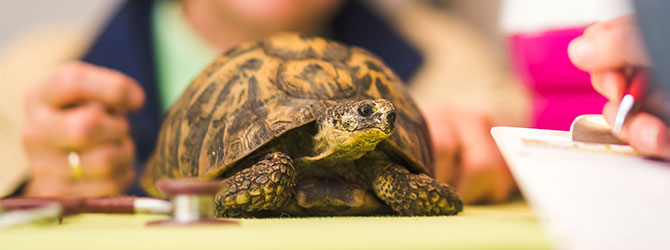Comprehensive Tortoise Hibernation Guide: Expert Tips for Safe Hibernation
First Published: 04/01/2019
Last Updated: 24/01/2024
It is a common misconception that all tortoises hibernate in winter: some species of tortoise need to hibernate, some may or may not hibernate, and others do not hibernate at all.
Not only do different species vastly vary in size, diet, and lifespan, it’s important to know which category the breed you’re thinking of getting falls into.
If you are thinking of welcoming a tortoise to your family, you will need to do your research into the species you’re considering. A specialist reptile or exotic vet can help you make the right choice.
Should I hibernate my tortoise?
Generally speaking, tropical tortoises such as the leopard tortoise don’t need to hibernate. Hibernating can be risky for very small tortoises, so never try to hibernate a sick or underweight tortoise that has not fed well throughout the summer. It is suggested not to hibernate a tortoise under 3 years of age and using the Jackson ratio can help determine if your tortoise is the correct weight and size to hibernate.
Preparing a tortoise for hibernation
Tortoises should only hibernate if they’re in good physical shape. Feeding them a healthy, balanced diet during the summer months can help them prepare for their long sleep.
You’ll need to decide around the middle of August if your pet is in the right physical shape for hibernation. He’ll need to have laid down sufficient fat stores – as well as water and vitamins – during the active summer months, to be ready for his long rest.
It’s a good idea to get a specialist vet to examine your tortoise in late August or early September to check for any signs of disease. If your vet gives him the all clear, set a date at the end of October or early November to start hibernation, and start to keep him warm in a vivarium or on a tortoise table.
Starving your tortoise before hibernation
Your tortoise needs a full bladder but empty bowels before they hibernate. This can be done by bathing them daily for up to two weeks before hibernation. They should be starved during this 2-week bathing period. They absorb water to hydrate themselves this way and it encourages them to defecate.
It may sound cruel, but you’ll need to stop feeding your tortoise in good time before his planned hibernation date to reduce the risk of health problems while he sleeps through the winter. The length of time you need to starve your tortoise depends on his age.
During the last week to two weeks before hibernation, reduce the temperature and day length in the vivarium.
What do I need to hibernate my tortoise?
- A fridge
- An ice cream tub, plastic storage box or lunchbox, a little larger than your tortoise
- A tight-fitting lid punched with air holes
- Kitchen towel
Important note…
You’ll need a separate fridge to hibernate your tortoise, not the fridge you use to store your food and drink, for hygiene reasons.
Hibernating your tortoise
You can hibernate your tortoise in a fridge or a well-insulated box. Most experts recommend the fridge method because it’s possible to control the temperature (to roughly 5 degrees Celsius) so we’ll focus on that method.
Place your tortoise inside the box and place him in the fridge. Check him every day, and weigh him once a week. It is very important to check daily to allow fresh air into the fridge.
How long should I hibernate my tortoise?
The tortoise trust recommends a minimum of 8-10 weeks for small tortoises and no more than 16 weeks for larger ones.
Important note…
Experts recommend you hibernate your tortoise for just three weeks first time round, whatever his age.
Waking your tortoise from hibernation
Once the hibernation period is up, remove your tortoise from the fridge and place him near a heat source such as a basking or UV lamp to help him acclimatise. He should gradually become active after two to three hours. Encourage him to drink, and bathe him in lukewarm water to allow him to rehydrate and flush out any toxins that have accumulated in his body.
Increase the temperature of his environment and bathe him daily in the days that follow, and start to feed him within a day or two. If not eating within 1-2 weeks then get him checked over.
Find your nearest vet using our Find a Vet page, or speak to a vet online using Online Vets.


